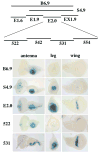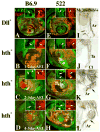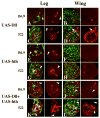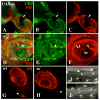Regulation of the Drosophila distal antennal determinant spineless
- PMID: 17084833
- PMCID: PMC1876787
- DOI: 10.1016/j.ydbio.2006.09.044
Regulation of the Drosophila distal antennal determinant spineless
Abstract
The transformation of antenna to leg is a classical model for understanding segmental fate decisions in Drosophila. The spineless (ss) gene encodes a bHLH-PAS transcription factor that plays a key role in specifying the identity of distal antennal segments. In this report, we identify the antennal disc enhancer of ss and then use enhancer-lacZ reporters to work out how ss antennal expression is regulated. The antennal determinants Distal-less (Dll) and homothorax (hth) are key activators of the antennal enhancer. Dll is required continuously and, when present at elevated levels, can activate the enhancer in regions devoid of hth expression. In contrast, homothorax (hth) is required only transiently both for activation of the enhancer and for specification of the aristal portion of the antenna. The antennal enhancer is repressed by cut, which determines its proximal limit of expression, and by ectopic Antennapedia (Antp). Repression by Antp is not mediated by hth, suggesting that ss may be a direct target of Antp. Finally, we show that ss+ is not a purely passive target of its regulators: ss+ partially represses hth in the third antennal segment and lies upstream of Dll in the development of the maxillary palp primordia.
Figures










Similar articles
-
Control of distal antennal identity and tarsal development in Drosophila by spineless-aristapedia, a homolog of the mammalian dioxin receptor.Genes Dev. 1998 May 1;12(9):1290-303. doi: 10.1101/gad.12.9.1290. Genes Dev. 1998. PMID: 9573046 Free PMC article.
-
Control of the spineless antennal enhancer: direct repression of antennal target genes by Antennapedia.Dev Biol. 2010 Nov 1;347(1):82-91. doi: 10.1016/j.ydbio.2010.08.012. Epub 2010 Aug 18. Dev Biol. 2010. PMID: 20727877 Free PMC article.
-
The spineless-aristapedia and tango bHLH-PAS proteins interact to control antennal and tarsal development in Drosophila.Development. 1999 Sep;126(17):3937-45. doi: 10.1242/dev.126.17.3937. Development. 1999. PMID: 10433921
-
Limb development: getting down to the ground state.Curr Biol. 2001 Dec 11;11(24):R1025-7. doi: 10.1016/s0960-9822(01)00616-9. Curr Biol. 2001. PMID: 11747840 Review.
-
Spineless provides a little backbone for dendritic morphogenesis.Genes Dev. 2006 Oct 15;20(20):2773-8. doi: 10.1101/gad.1487706. Genes Dev. 2006. PMID: 17043306 Review. No abstract available.
Cited by
-
Single-cell RNA sequencing of mid-to-late stage spider embryos: new insights into spider development.BMC Genomics. 2024 Feb 7;25(1):150. doi: 10.1186/s12864-023-09898-x. BMC Genomics. 2024. PMID: 38326752 Free PMC article.
-
CRISPR/Cas9-Mediated Mutagenesis of Antennapedia in Spodoptera frugiperda.Insects. 2023 Dec 29;15(1):16. doi: 10.3390/insects15010016. Insects. 2023. PMID: 38249022 Free PMC article.
-
Chromosomal binding sites of the homeotic cofactor Homothorax.Mol Genet Genomics. 2008 Jul;280(1):73-81. doi: 10.1007/s00438-008-0347-0. Epub 2008 May 15. Mol Genet Genomics. 2008. PMID: 18481089
-
The pleiotropic functions of Pri smORF peptides synchronize leg development regulators.PLoS Genet. 2023 Oct 30;19(10):e1011004. doi: 10.1371/journal.pgen.1011004. eCollection 2023 Oct. PLoS Genet. 2023. PMID: 37903161 Free PMC article.
-
Precise staging of beetle horn formation in Trypoxylus dichotomus reveals the pleiotropic roles of doublesex depending on the spatiotemporal developmental contexts.PLoS Genet. 2019 Apr 10;15(4):e1008063. doi: 10.1371/journal.pgen.1008063. eCollection 2019 Apr. PLoS Genet. 2019. PMID: 30969957 Free PMC article.
References
-
- Abu-Shaar M, Mann RS. Generation of multiple antagonistic domains along the proximodistal axis during Drosophila leg development. Development. 1998;125:3821–3830. - PubMed
-
- Abzhanov A, Kaufman TC. Homologs of Drosophila appendage genes in the patterning of arthropod limbs. Dev Biol. 2000;227:673–689. - PubMed
-
- Angelini DR, Kaufman TC. Functional analyses in the hemipteran Oncopeltus fasciatus reveal conserved and derived aspects of appendage patterning in insects. Dev Biol. 2004;271:306–321. - PubMed
-
- Burgess EA, Duncan I. Direct control of antennal identity by the spineless-aristapedia gene of Drosophila. Mol Gen Genet. 1990;221:347–352. - PubMed
Publication types
MeSH terms
Substances
Grants and funding
LinkOut - more resources
Full Text Sources
Molecular Biology Databases

